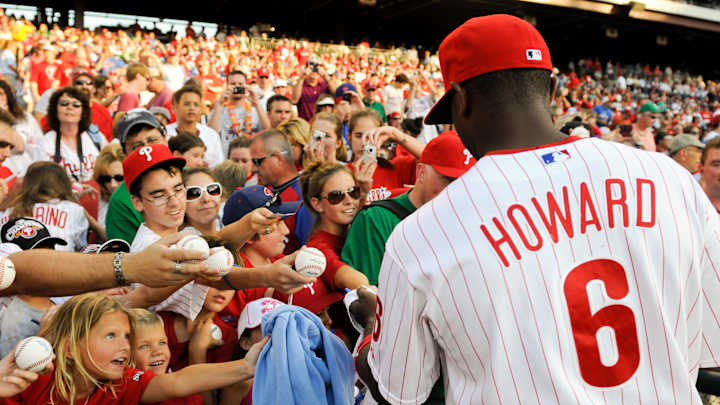Is Ryan Howard a Hall of Famer?

17 years ago, Ryan Howard made his major league debut with the Philadelphia Phillies, a team and a city in which he would become a beloved member. After a 13-year career, was Howard great enough to earn a plaque in Cooperstown?
Howard has been retired from MLB for five years, meaning he is appearing on the Baseball Hall of Fame ballot, along with former teammate Jimmy Rollins, for the first time.
Howard's career can serve as a story of two halves, the first-half being a great one, which would bode well for a shot at Cooperstown, but as for the second-half, it'd be difficult to say the same thing.
Throughout his 13 years in the majors, Howard hammered 382 home runs, drove in 1,194 RBI, and finished with a slugging percentage of .515. To say that Howard was an offensive force to be reckoned with during his prime is an understatement.
Howard's prime can be sectioned down to the five seasons between 2006 and 2011 where he went off setting records and bringing home some impressive silverware.
During this period, Howard averaged 44 home runs, 133 RBI, and a slugging percentage of .559 a season. Howard's accumulated accolades during this era include five All-Star appearances, a Silver Slugger, a NL MVP award, a World Series ring, and the Home Run Derby champion.
Beyond these accomplishments, Howard also broke the Phillies single-season home run record with 58 in 2006, as well as becoming the fastest player to 100 home runs, doing so in 325 games, as well as 200 home runs, doing so in 658 games.
The Big Piece was on fire, but that fire would start to dim as a result of an injury-riddled second-half of his career, with the point of slowing down beginning in the last play of the 2011 NLDS against the St. Louis Cardinals after Howard tore his Achilles.
As a result of his numerous injuries, Howard's offensive output over the second-half of his career was greatly reduced, now averaging 19 home runs, 66 RBI, and a slugging percentage of .427 a season.
When looking at Howard's career overall in comparison to the other recent first baseman inductees like Jeff Bagwell, Frank Thomas, and Jim Thome, it's apparent that Howard's latter half really took a chunk out of his chances.
Thomas and Thome both hit over 500 home runs and 1,400 RBIs, something that Howard can't say the same about. Amongst other reasons such as Thomas' two MVP awards or his four Silver Sluggers. Both of them were first-ballot Hall of Famers, which is well-deserved when looking at their career stats, and Howard lags behind them in that regard.
Howard might not reach Cooperstown in the period of time as Thomas and Thome did, but he might be more in line with Bagwell or Larry Walker.
Bagwell's and Walker's careers were similar to Howard's, both were offensive units during their peaks and saw a lot of accolades come their way, and in both cases, were MVPs, Silver Sluggers, and All-Stars.
In comparison to Howard's career numbers with 382 homers, 1,194 RBI, and a .515 slugging percentage, Bagwell hit 449 home runs, 1,529 RBI, and a .540 slugging percentage, and Walker with 383 dingers, 1,311 RBI, and .565 slugging.
Even though both were members of the 300 home run club, they struggled to get the 75% of votes required to be inducted into the Hall of Fame, for Bagwell it took six years, and for Walker, it took a decade before he received a phone call from Jack O'Connell, president of the BBWAA, informing him that he had been inducted, it was Walker's last year on the ballot before his name would've been taken off.
With Howard's resume closely mirroring that of Walker and Bagwell, so may his path to getting inducted into Cooperstown. As it currently stands, players have a decade on the ballot and if they don't get voted in within that decade, their name is taken off.
For now, Howard, Rollins, the rest of this year's ballot, and fans across the world will have to wait until Jan. 25, 2022, for the results of the vote to be announced.
More From SI's Inside The Phillies:
- Bryce Harper Wins National League MVP Award
- Is Bryson Stott Ready to Be the Phillies' Everyday Shortstop?
- This Player Just Makes Too Much Sense for the Phillies
Make sure to follow Inside the Phillies on Facebook and Twitter!
